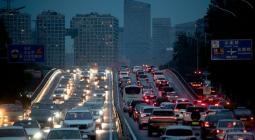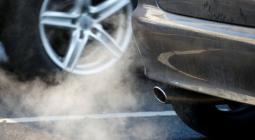'Surprisingly rapid' rebound in carbon emissions post-lockdown.

Busier roads to blame, with fears of worse to come as workers shun public transport.
Carbon dioxide emissions have rebounded around the world as lockdown conditions have eased, raising fears that annual emissions of greenhouse gases could surge to higher than ever levels after the coronavirus pandemic, unless governments take swift action.
Emissions fell by a quarter when the lockdowns were at their peak, and in early April global daily carbon dioxide emissions were still down by 17% compared with the average figure for 2019, research published last month in the journal Nature Climate Change found.
Now daily carbon emissions are still down on 2019 levels, but by only 5% on average globally, according to an updated study.
“Things have happened very fast,” said Corinne Le Quéré, a professor of climate change at the University of East Anglia and the lead author of the studies. “Very few countries still have stringent confinement. We expected emissions to come back, but that they have done so rapidly is the biggest surprise.”
Emissions for the year to date, from 1 January to 11 June, are 8.6% lower than in the same period for 2019, and emissions for the whole of this year are likely to be between 4% and 7% lower than for the whole of last year. That is not enough to make a significant contribution to the cuts in emissions needed to fulfil the Paris agreement on climate change, which will require structural changes to transport systems and how energy is generated.
In the UK, emissions had fallen by 31% in early April, when the lockdown was at its most restrictive. But this week daily emissions were found to be 23% lower than last year’s levels. The reduction is likely to shrink further as the lockdown is loosened.
Most of the fall and subsequent rebound has come from road transport. Deserted streets and empty motorways swiftly became the norm during lockdown, as people were ordered to stay at home except for emergencies.
“Road transport is the most responsive sector,” said Le Quéré. “Emissions from transport were always going to go back up, but government responses have not been as fast as I would have liked [to make changes to people’s driving habits]. It would be terrible if we carry on going back to normal. It would be a disaster.”
Mike Childs, the head of science at Friends of the Earth, said ministers in the UK had sent mixed signals. Boris Johnson, in his address last month announcing the first lockdown easing, explicitly urged people to drive to work.
“By saying that people should jump back into cars, the government are contributing to increased pollution,” Childs said. “Road use was the big problem, and cycling and walking provision has always been part of the solution – just more so now, as we emerge.”
Air pollution has not rebounded as fast as carbon dioxide emissions in Europe, according to estimates from the Copernicus Atmosphere Monitoring Service, which found that the expected increase in pollutants such as nitrogen oxides and particles was not yet apparent. However, this could be owing to many factors including the weather.
While emissions overall are still down on last year, there are fears that as lockdowns around the world ease further in the coming months, carbon from cars could surge to levels higher than before the pandemic as people avoid public transport.
“What we may now see are emissions that exceed pre-pandemic levels, if for instance more people start using private instead of public transport due to health concerns,” said Bob Ward, a policy director at the Grantham Research Institute on Climate Change at the London School of Economics. “Any economic recovery packages designed to help economies fully rebound need to focus on zero-carbon climate resilient investments that address unemployment but avoid locking us into a new high-carbon future.”
Le Quéré said the role of governments around the world would be key. “There is the possibility [of emissions surging to well above pre-crisis levels] if the government incentives for boosting the economy are blind to climate change. Building roads, for example, would be very detrimental.”
But the hope of making some of the emission reductions permanent was not yet lost, she said. Governments could still use their economic rescue packages to encourage a switch from high to low carbon infrastructure, for instance by removing the obstacles to electric vehicle adoption, by renovating buildings to make them more energy efficient, and by planting trees and restoring nature.
“The window of opportunity will not be closed until the end of the year,” she said. “But after that it will be closed.”
Richard George, of Greenpeace UK, said forging a green recovery should be an urgent priority. “All effort now needs to be focused on supporting a green economic recovery, creating jobs and boosting clean technologies,” he said. “We have a once-in-a-lifetime opportunity to create a permanent silver lining. Let’s not throw it away.”
11 June 2020
Τhe Guardian




